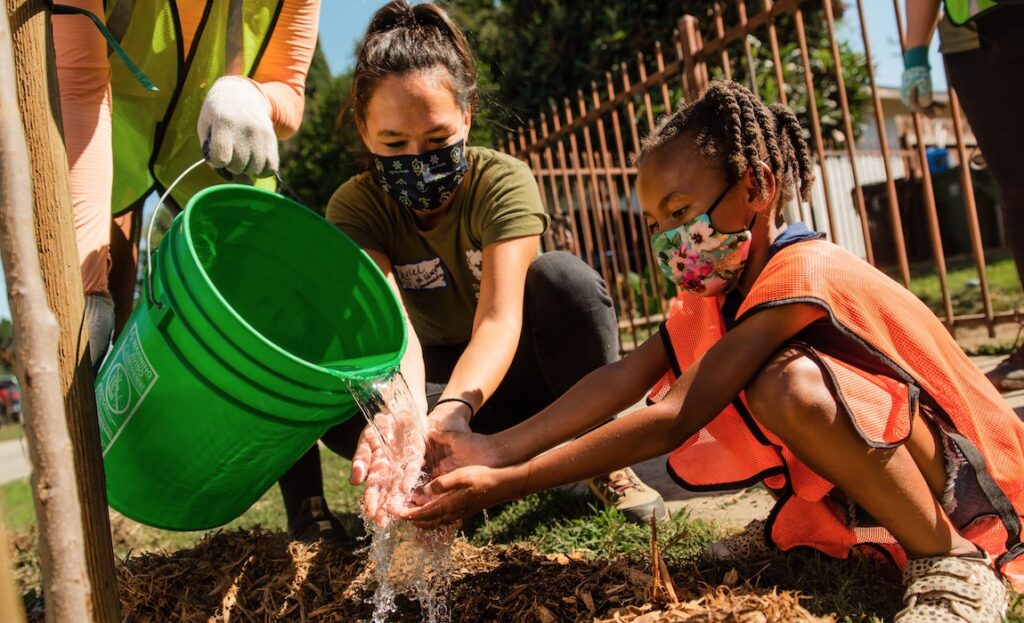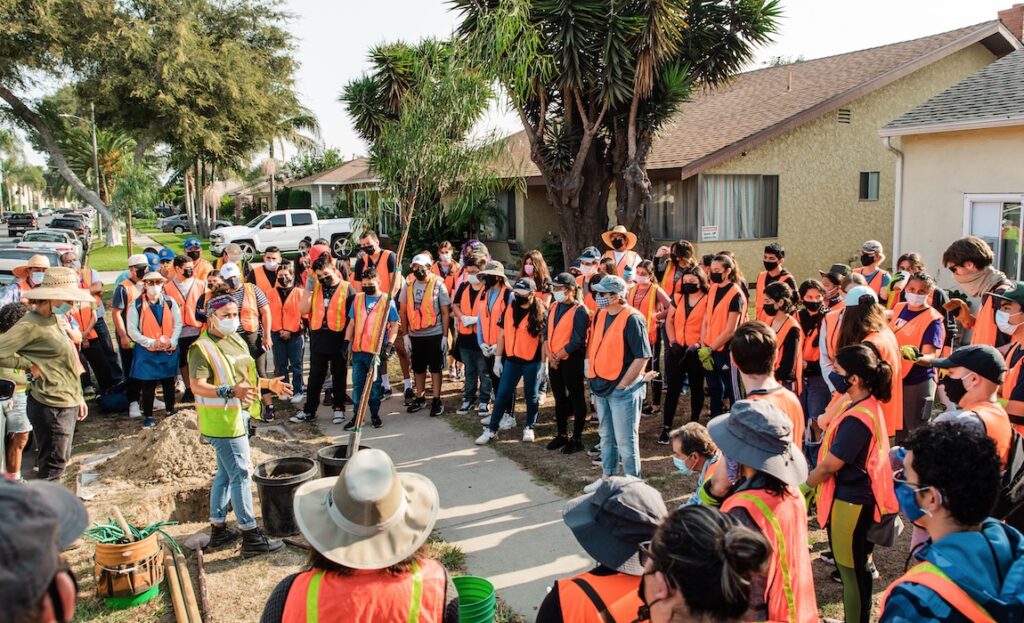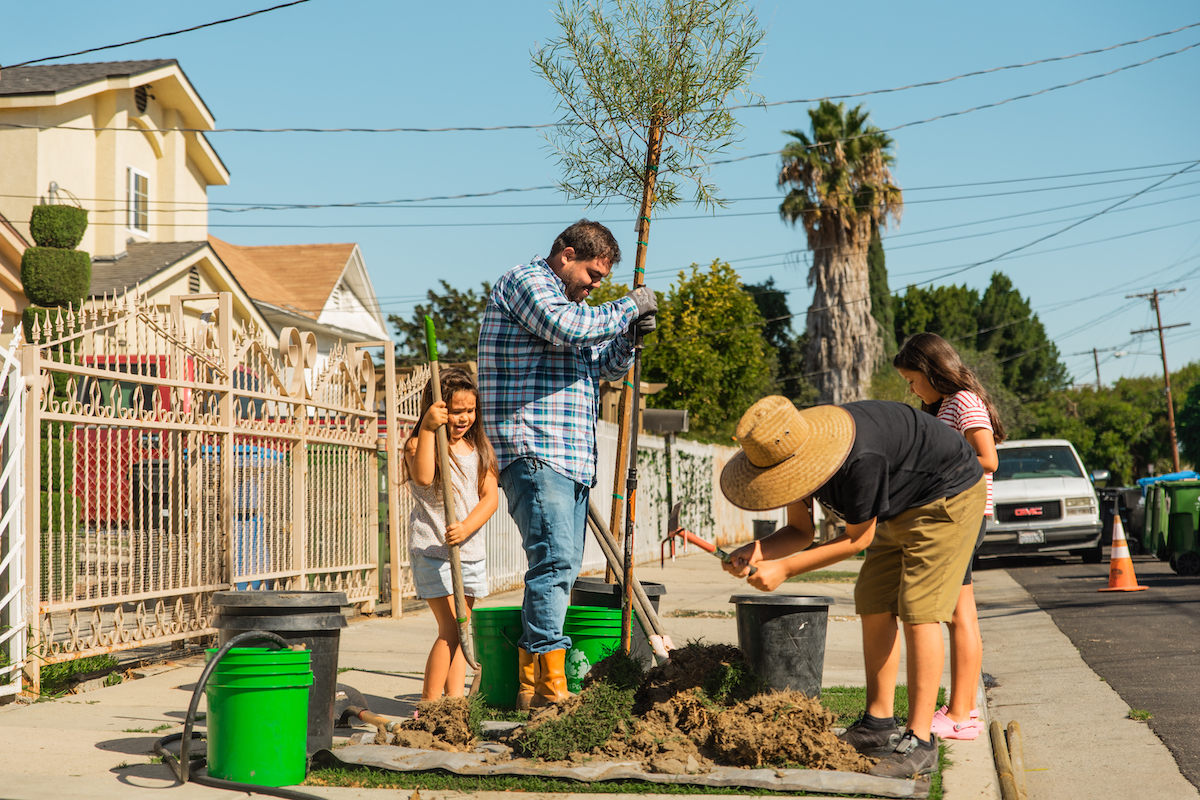(Above: In 2021, TreePeople planted 700 trees in Watts, as part of its 50-year effort to address environmental inequality. Credit: TreePeople)
A recent UCLA study found that bringing green space in LA County to median levels could add up to 908,800 years of collective life expectancy to residents in under-resourced communities.
The peer-reviewed study, published in Environment International, is the first in the U.S. to combine census tract life expectancy data with neighborhood vegetation data, providing Southern California policymakers with a model of reducing health inequality by greening low-income neighborhoods.
Researchers found that bringing greenery to median levels in each census tract would bring between 570,300 and 908,800 years of collective life expectancy to disadvantaged residents. Greening wealthy Westside neighborhoods was not found to significantly affect expectancy after controlling for variables like smoking, obesity and physical inactivity.
Keep cool, plant trees
For some, however, the findings of this study are not new: TreePeople, a nonprofit which describes itself as “the largest environmental movement headquartered in Southern California,” has been researching, restoring, and replanting urban greenery in environmentally stressed LA County areas for 50 years.
Eileen Garcia, Director of Community Forestry at TreePeople, said that since 1973, over three million volunteers have planted trees and seen firsthand how a community’s green inequality worsens environmental and public health conditions like pollution and heat-related illness.
The UCLA study confirmed that trees were the most effective component of urban forestation when it came to heat mitigation, keeping ground-level temperatures about 2 degrees Fahrenheit cooler with each 10% of canopy cover. Shrubs cooled by 0.7 Fahrenheit with each 10% of cover.
In LA County, which spans 10 million people across 4,000 square miles, two-thirds of the Black and Latino population lives in areas with disproportionately less green vegetation — namely east LA, south LA, and far north areas.

The UCLA study found that merely expanding park access to LA County medians would add 164,700 years of life expectancy to the region. Latino and Black residents would receive about 72%, or 118,000 of these years.
Though TreePeople mostly focuses its efforts on drought-tolerant street tree species like crepe myrtle and gold medallion, parks — like Coldwater Canyon in the Santa Monica Mountains, where the organization is based — offer a plantable space for larger native species, like oaks.
Concrete jungle
The areas of LA most needing reforestation, however, are not only the lowest in life expectancy, but also the least plantable. In a city where over half the surfaces are dark concrete or asphalt, which absorbs up to 90% of solar radiation, this inequality is deadly. While the study found that life expectancy in financially and verdantly green Beverly Hills is as high as 90, the median in south LA communities less than 15 miles away is 77.
Many of these communities “suffer shade inequity presented by low tree canopy coverage due to the fact that they’re flanked by freeways and sit in a basin,” explained Garcia. “Where it’s heavily polluted, it’s even harder to plant around a major roadway or warehouse.”
“Furthermore,” she added, researchers looking to raise life expectancy through urban greening sometimes overlook the fact that “mountains are the lungs of our city. Reforestation efforts must extend to burn areas around LA.”
Addressing air quality issues
In light of ever-worsening wildfire seasons, this focus is especially pertinent. The Air Quality Life Index, an annual report from the University of Chicago, found last June that particulate air pollution — including wildfire smoke, which accounts for up to half of all fine-particle pollution in the Western U.S. — removes over two years from the global average life expectancy (more than cigarettes, alcohol, or terrorism).
That same report found that 29 of the 30 counties with the worst particulate pollution in 2020 were in California, including LA.
To counter this, TreePeople obtained a grant through CalFIRE in 2020 to plant and maintain 1,000 trees in the southern city of Lynwood (next to Watts, where the organization also planted 700 trees in 2021). The funding allowed volunteers to utilize Light Detection and Ranging technology, scanning the city with low-flying aircraft to determine ideal tree topography.

Alongside this technology, feedback from Lynwood community allowed volunteers to focus planting in high-need areas, not only creating a barrier against pollution near freeways, but also creating shaded paths to schools and city facilities. The response to this was so positive that, even as the maintenance phase for this project continues, TreePeople is currently seeking grants to fund more trees in Lynwood.
“The City Council approached us asking how we can work together again, and we gave 250 fruit trees to the city. We even inspired community members to advocate for the transformation of an empty lot and dumping ground into a community garden,” said Garcia. “Our presence in the communities we help doesn’t end when we’re done planting, as we water and maintain each tree for three to five years.”
Environmental messaging
Alongside further planting efforts — in July 2023, TreePeople began distributing 2,000 shade trees and planting 4,000 more trees in under-greened areas with the South LA Eco-Lab — addressing mixed environmental messages has also been key to enriching the lives of LA County residents.
“This is often overlooked by policymakers,” said Garcia. “If you plant a tree in someone’s yard, they have to care for it once a week, and yet one of the most common messages they hear is not to water their yard in the summer or during a drought,” said Garcia. “They’re not being asked to not water trees, just to not water lawns. We’ve partnered with the Metropolitan Water District to bridge this communication gap.”
“Everyone wants a green neighborhood, they want access to unpolluted air and they want the cooling benefits of shade,” she added. “The data shows that the challenges are systemic, they’re being faced in communities that have been historically redlined. Overcoming these challenges is deeper-rooted than planting a tree; that’s where it starts.”




